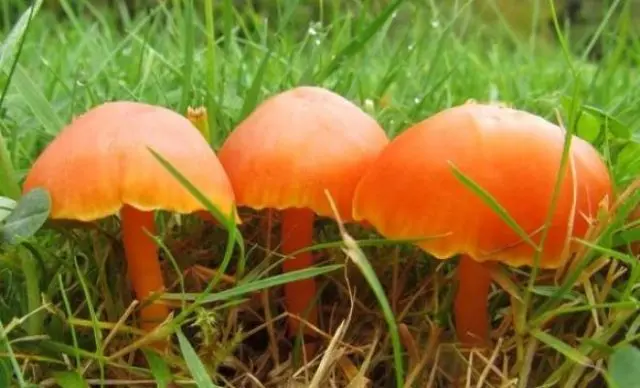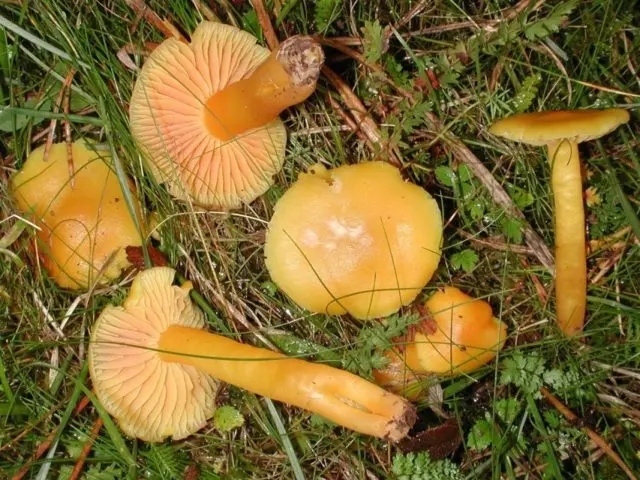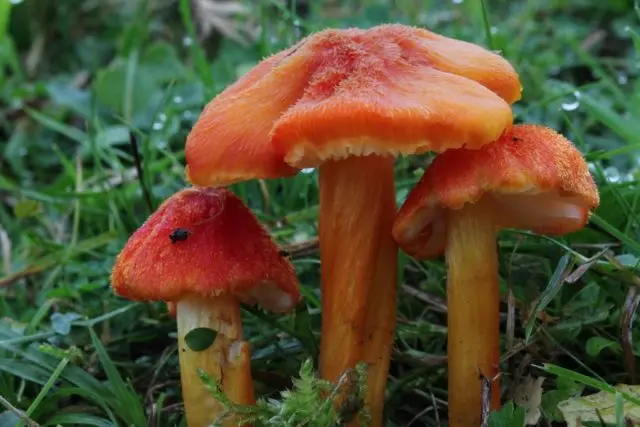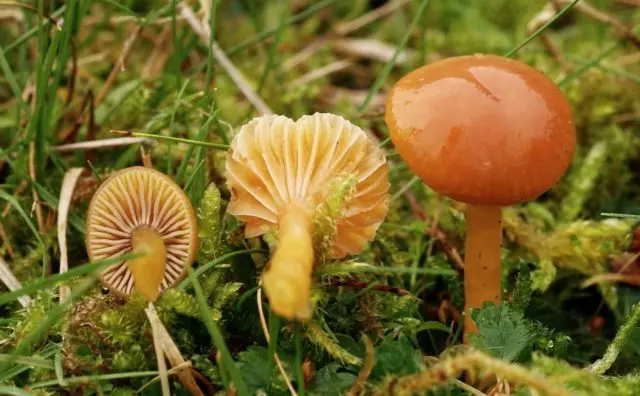Contents
The representative of the Hygrophoraceae family – oak hygrocybe – is a bright basidiomycete that grows everywhere in mixed forests. It differs from other brethren by a pronounced oily smell. In the scientific literature, you can find the Latin name of the species – Hygrocybe quieta.

This is a conspicuous, orange mushroom, shaped like small umbrellas.
What does oak hygrocibe look like
In young specimens, the cap is conical, becoming prostrate over time. Its diameter does not exceed 5 cm. With high humidity, the surface becomes oily, sticky, in sunny weather – smooth and dry. The color of the fruit body is yellow-hot, with an orange tint.

Hymenophore (reverse side of the cap) consists of rare yellow-orange plates that branch out at the edges
The flesh is whitish with a yellowish tint, fleshy, the taste is not pronounced, the aroma is oily.
The leg is cylindrical, thin, fragile and brittle, the surface is smooth. In young specimens, it is even, in old specimens it becomes curved or twisted. Inside it is hollow, the diameter does not exceed 1 cm, and the length is 6 cm. The color matches the hat: bright yellow or orange. Whitish spots may appear on the surface. Rings and films are missing.
Spores are ellipsoid, oblong, smooth. Spore powder white.
Where does oak hygrocybe grow
Basidiomycete of the Hygrophoraceae family reproduces in deciduous or mixed forests. Prefers to grow under the shade of an oak tree. That’s why it got its name. It is distributed throughout Europe and Our Country. Fruits mainly in autumn.
Is it possible to eat hygrocibe oak
The described fungus is not poisonous, it does not pose a danger to the human body. But it has a mediocre taste, which is why it has not become a favorite among mushroom pickers. When broken, the hat exudes a strong oily aroma. Scientists attribute oak hygrocybe to conditionally edible species.
False doubles
Many representatives of the Hygrophoraceae family are similar to each other. The described basidiomycete also has a counterpart similar to it – the intermediate hygrocybe, the Latin name is Hygrocybe intermedia.

The double has a dark orange color, its hat is larger in diameter, umbrella-shaped, with a noticeable tubercle or hole in the center
The skin is dry and smooth, loose, covered with small scales, it looks like wax. The edges of the cap are brittle, often cracking. The hymenophore is white, with a yellowish tint.
The leg is long and thin, yellow in color, with red veins, they are lighter near the cap.
Basidiomycete lives in mixed forests, in glades with tall grass and fertile soil. The fruiting period is autumn.
The taste and aroma of the double is not expressed. It is classified as a conditionally edible species.
Another double is a beautiful hygrocybe. The shape of the fruiting body and the dimensions of the twin are absolutely identical to the oak hygrocybe. The color of a similar species is gray, olive or light lilac.

As they mature, twins from the Hygrophoraceae family acquire a fiery red color and become completely similar to oak hygrocybe
The plates are even, frequent, light yellow, adhere to the stem and, as it were, descend onto it. The edges of the cap are even, do not crack.
This is a rare mushroom that is practically not found in the forests of Our Country. It is classified as edible. Some mushroom pickers distinguish its good taste and bright aroma.
Conclusion
Oak hygrocybe is a catchy, beautiful mushroom with a specific smell. Rarely found in forests. The fruit body is small, so picking up a basket of such mushrooms is quite problematic. They grow not only in forests and oak groves, but also in meadows, pastures, well-lit glades with high humidity. This basidiomycete is not whimsical to the composition of the soil.









